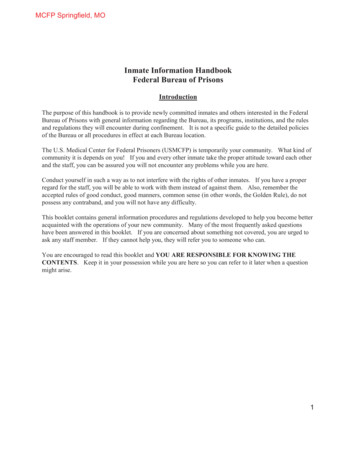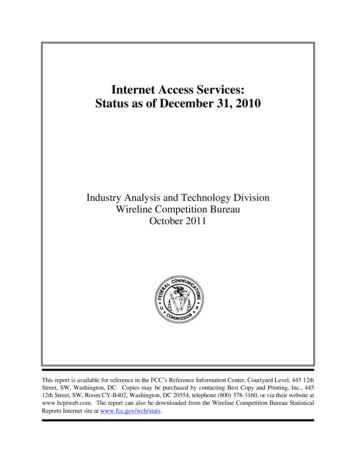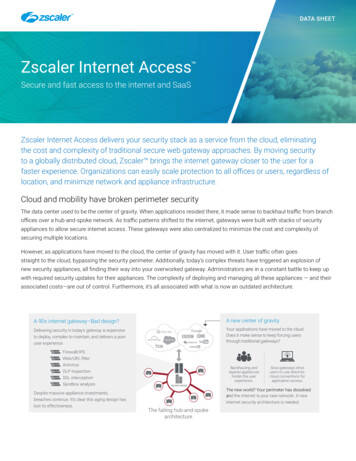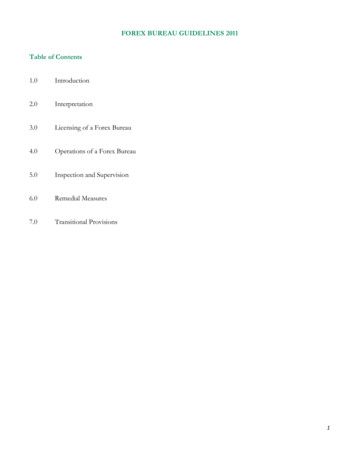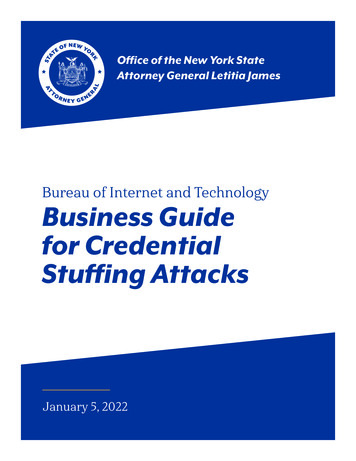
Transcription
Office of the New York StateAttorney General Letitia JamesBureau of Internet and TechnologyBusiness Guidefor CredentialStuffing AttacksJanuary 5, 2022
IntroductionVirtually every website and app uses passwords as a means of authenticating its users. Users — forced tocontend with an ever-expanding number of online accounts they must manage — tend to reuse the samepasswords across multiple online services. Unfortunately, the widespread use and reuse of passwords hasmade them attractive targets to cybercriminals, who know that passwords stolen from one company mayprovide the keys to a host of accounts at another.According to a recent study, there are more than 15 billion stolen credentials circulating on the Internet.1 Thisenormous cache of credentials has fueled a dramatic rise in credential stuffing attacks. The operator of onelarge content delivery network reported that it witnessed more than 193 billion such attacks in 2020.2These attacks are extraordinarily costly for both businesses and consumers. The Ponemon Institute’s Cost ofCredential Stuffing report found that businesses lose an average of 6 million per year to credential stuffing inthe form of application downtime, lost customers, and increased IT costs.3In light of this growing threat, the Office of the New York State Attorney General (OAG) launched aninvestigation to identify businesses and consumers impacted by credential stuffing. Over the course of thisinvestigation, the OAG was able to review and evaluate the effectiveness of a wide range of safeguards againstcredential stuffing. The purpose of this document is to share some of the lessons learned, including concreteguidance to businesses on steps they can, and should, take to better protect against credential stuffingattacks.4Digital Shadows, From Exposure to Takeover: The 15 billion stolen credentials allowing account takeover (2020), nd-reports/from-exposure-to-takeover1Akamai, Phishing for Finance (May 2021), -finance-report-2021.pdf2Ponemon Institute, The Cost of Credential Stuffing (2017), of-credentialstuffing-report34This guide is not intended to supersede existing federal or state laws or regulations concerning data security.2
A. What is Credential Stuffing?Credential stuffing is a type of cyberattack that typically involves repeated attempts to log in to online accountsusing usernames and passwords stolen from other online services. It leverages the natural human tendency toreuse passwords to cope with the ever-growing number of online accounts that must be managed. Attackersknow that the username and password used at one website may also be used at a half-dozen others.Unlike many other types of cyberattacks, credential stuffing attacks often require little technical knowledgeto mount. Attackers typically use free, easily accessible software capable of transmitting hundreds of loginattempts simultaneously without human intervention. A single attacker can easily send hundreds of thousands,or even millions, of login attempts to a single web service.Although most login attempts in a credential stuffing attack will fail, a single attack can nevertheless yieldthousands of compromised accounts due to the sheer volume of attempts. Attackers have a variety of waysof monetizing these compromised accounts. They can, for example, make fraudulent purchases using thecustomer’s saved credit card, steal and sell a gift card that the customer has saved on the account, use customerdata stolen from the account in a phishing attack, or simply sell the login credentials to another individual on thedark web.3
B. Our InvestigationOver a period of several months, the OAG monitored several online communities dedicated to credentialstuffing. The OAG found thousands of posts containing login credentials that had been tested in credentialstuffing attacks on a website or app and confirmed to provide access to a customer account. Members of thesecommunities were free to use these validated credentials to break into the customer accounts themselves, or usethem for their own credential stuffing attacks on other companies’ websites and apps.Screenshot of post sharing validated customer account credentialsAfter reviewing thousands of posts, the OAG compiled login credentials for customer accounts at 17 well-knowncompanies, which included online retailers, restaurant chains, and food delivery services. In all, the OAG collectedcredentials for more than 1.1 million customer accounts, all of which appeared to have been compromised incredential stuffing attacks.The OAG contacted each of the 17 companies to alert them to the compromised accounts. The OAG also askedthe companies to investigate and take steps to protect impacted customers. Every company did so.The OAG also worked with the companies to determine how attackers had circumvented existing safeguards,and advised companies on steps they could take to enhance their data security programs and better securecustomer accounts against credential stuffing. Over the course of the OAG’s investigation, nearly all of thecompanies introduced, or presented plans to introduce, additional safeguards.4
Protecting Customers from CredentialStuffing AttacksCredential stuffing attacks have become so prevalent that they are, for most businesses, unavoidable. Everybusiness that maintains online accounts for its customers should therefore have a data security program thatincludes effective safeguards for protecting customers from credential stuffing attacks in each of four areas:1. Defending against credential stuffing attacks,2. Detecting a credential stuffing breach,3. Preventing fraud and misuse of customer information, and4. Responding to a credential stuffing incident.In the sections below, the OAG presents specific safeguards that have been found to be effective in each of theseareas. The list is not exhaustive, but rather highlights safeguards that may be applicable to a broad range ofbusinesses. However, not every safeguard will be appropriate for every business. Businesses should evaluatewhich safeguards to implement in the context of their own operations, considering factors like the size andcomplexity of the business, the volume and sensitivity of customer information that it maintains, the risk andscale of injury, and the software and systems that are already in use.It is important to note that the effectiveness of the safeguards identified below will likely change over time asattackers adopt new tactics. Businesses should regularly evaluate the effectiveness of their own controls andimplement new safeguards as appropriate.A. Defending Against a Credential Stuffing AttackEvery business should maintain effective safeguards for defending against unauthorized access to customeraccounts through credential stuffing attacks. For many businesses, this will require implementing an effectivetechnical safeguard, like bot detection software or multi-factor authentication, as well as foundationalsafeguards, such as a web application firewall.5
Most Effective Safeguards1. Bot DetectionCredential stuffing attacks typically involve tens or hundreds of thousands of login attempts that have beengenerated by automated software, or “bots.” One of the most effective controls for mitigating this type ofattack is a bot detection system — software specifically designed to identify and block bot-generated Internettraffic. Effective bot detection systems can distinguish between human and bot traffic even when the bottraffic has been disguised — for example, by rotating through multiple IP addresses or device identifiers.Although bot detection systems can be developed in-house, many companies use third-party bot detectionand mitigation services. One advantage of a third-party service is that it can operate across hundreds ofwebsites and apps, providing access to a vast amount of data that can help reveal bot patterns that wouldnot be apparent to a single website operator.Bot detection can be highly effective at mitigating credential stuffing attacks. One restaurant chain reportedto the OAG that its bot detection vendor had blocked more than 271 million login attempts over a 17-monthperiod. Another company the OAG contacted saw more than 40 million login attempts blocked over a twomonth period. Success stories like these have likely contributed to bot detection systems’ popularity — 12 ofthe companies the OAG contacted have implemented or have plans to implement a bot detection system.CAPTCHA systems, which take a different approach to distinguishing between humans and bots, may notbe as effective as other bot detection technologies. Software has become adept at solving many types ofCAPTCHA challenges without human intervention. In addition, CAPTCHA challenges can be completed byactual humans in CAPTCHA farms, typically located overseas.2. Multi-Factor AuthenticationAnother effective safeguard for preventing credential stuffing attacks is multi-factor authentication, alsoknown as MFA. MFA requires a user to present two or more types of credentials in order to log in to theiraccount. The credentials must come from two (or more) of the following categories:1. Something the user knows (like a password),2. Something the user has (like a mobile phone), and3. Something the user is (like a fingerprint).Most attackers that have access to a stolen password will not have access to other credential types.Although MFA was historically used by organizations that maintained highly sensitive information, such asfinancial institutions, in recent years MFA has seen more widespread adoption. Six of the companies the OAGcontacted use or have plans to implement MFA.6
Companies often implement a second factorthrough one of three mechanisms:Practice Tip1. A physical security key,2. An authenticator app, or3. Email or SMS text messages thatcontain a one-time code or link.Physical security keys and authenticator apps areoften more secure methods of authentication, astechniques like SIM swapping and social engineeringcan allow determined attackers to steal a codesent via text message or email. When selecting amechanism to implement, businesses should weighthe risk of harm from an unauthorized login againstthe complexity and ease of use of the MFA system.In a recent data breachinvestigation, the OAG uncoveredevidence that more than 140,000customer accounts had beencompromised in credential stuffingattacks against a business thatused multi-factor authentication.How had attackers bypassedMFA? They hadn’t. The OAGfound the MFA functionality hadbeen implemented incorrectly,rendering it ineffective.As with any safeguard,businesses should ensure theirMFA implementation is boththoroughly tested and monitoredfor effectiveness.Authentication code sent by SMS text message3. Passwordless AuthenticationPasswordless authentication is, as the name suggests, a method for authenticating users that does notrely on a password. Instead, users are authenticated using a different type of authentication factor, either“something the user has” or “something the user is.” Similar to MFA, most common implementations use anauthenticator app, a one-time authentication code sent via SMS or email, or an emailed link.Although passwordless authentication has not yet been widely adopted, it has gained traction in recentyears. One of the companies the OAG contacted relies on passwordless authentication.Other SafeguardsThe safeguards listed below can also be helpful in mitigating credential stuffing attacks, but typically should beused in conjunction with other, more effective safeguards.4. Web Application FirewallsMost businesses should use a Web Application Firewall (WAF) as a first line of defense against malicioustraffic. WAFs can include a variety of features capable of mitigating basic web application attacks.Sophisticated credential stuffing attacks, however, are often able to circumvent most WAF security measures.Several common WAF features are identified below.7
Rate limiting: In most cases, businesses should block or throttle traffic from any user that has attempted tolog in to multiple customer accounts in quick succession. This type of rate limiting is a low-cost control andcan be effective against basic attacks.5HTTP request analysis: Most WAFs analyze the header information and other metadata of incomingrequests to identify traffic that is likely to be malicious. Businesses should consider implementing HTTPrequest analysis and evaluate whether blocking or throttling requests with the following characteristicswould be effective in blocking malicious traffic:- Requests that use IP addresses, or originate from networks, that have been identified as malicious.- Requests that originate from a geographic area outside the customer base.- Requests that originate from virtual private server providers such as Amazon Web Servicesor commercial data centers.- Requests that originate from headless browsers, browsers that lack JavaScript execution engines,or have other attributes unique to common credential stuffing tools.IP address blacklist: Some businesses maintain a list of IP addresses that have recently engaged in attacks,and block or throttle traffic associated with those IP addresses. Businesses can also subscribe to threatintelligence feeds offered by third parties to populate IP address blacklists.5. Preventing Reuse of Compromised PasswordsBusinesses can stop attackers from accessing at least some customer accounts by preventing customersfrom reusing passwords that have previously been compromised. This functionality typically relies on thirdparty vendors that compile credentials from known data breaches. When a customer selects a password, itis compared to the passwords in the library of stolen data; if the password matches, the customer is asked tochoose another password.Attackers that disguise the source of a login attempt, for example by rotating through multiple proxy IP addresses, can often evaderate limiting controls.58
B. Detecting a Credential Stuffing BreachIn the never-ending arms race against attackers, nosafeguard is 100 percent effective. Every business shouldtherefore have an effective means of detecting credentialstuffing attacks that have bypassed other safeguards andcompromised customer accounts. In most cases, this willrequire systematic monitoring of customer traffic. Othersafeguards can supplement monitoring by providing a checkusing different sources of information.Most Effective Safeguard1. Monitoring Customer ActivityPractice TipSeveral of the companiesthe OAG contacted had notdetected the credential stuffingattacks that had compromisedtheir customers’ accounts.Credential stuffing attacks areinevitable. If your business isnot aware of credential stuffingattacks that have targetedyour customers’ accounts,chances are, your monitoringis inadequate.Most credential stuffing attacks can be identifiedthrough the footprints they leave on customer traffic.Attacks often appear as spikes in traffic volume orfailed login attempts. Even sophisticated credential stuffing attacks have attack signatures that can beidentified through analysis of customer activity. Most businesses should therefore have processes in place tosystematically monitor customer traffic.In most cases, monitoring should be at least partially automated to provide consistent, comparable metricsand round-the-clock surveillance. This automation might consist of a software process that runs in thebackground and alerts appropriate personnel if some benchmark is met; for example, when the numberof failed login attempts over a certain period of time exceed a predefined threshold. In other cases, moresophisticated monitoring techniques will be appropriate.WAFs and third-party bot detection services can provide effective monitoring capabilities as well as tools thatcan assist a business in reviewing customer traffic.Other SafeguardsIn most cases, the safeguards below will not be sufficient on their own to serve as an effective means of detectingsuccessful attacks. However, they can be effective supplements to other security controls, like systematicmonitoring.9
2. Monitoring Customer Reports of FraudCustomer reports of fraud and unauthorized access may indicate that customer accounts have beentargeted in a credential stuffing attack. For example, attacks may be reflected in the volume of customersupport inquiries a business receives. Patterns in what customers report — for example, repeated customercomplaints of stolen gift card balances or unauthorized orders placed to an unrecognized address — canalso indicate successful credential stuffing attacks.6Businesses should consider systematically monitoring customer reports of fraud and unauthorized accessfor evidence of attacks. This might involve, for example, the regular review of fraud case volume over timeto identify spikes or other patterns. Businesses should also set up clear channels of communication betweencustomer service and information security personnel in order to detect and stop credential stuffing attacksas quickly as possible.3. Notice of Account ActivityNotifying customers of unusual or significant account activity can serve several purposes. Notice provides thecustomer with an opportunity to review their account for unauthorized purchases or activity. If the customerdetermines the activity was unauthorized, they can report that unauthorized activity to the business. Thebusiness can then both take steps to protect the customer’s account and use the report to help determinewhether the unauthorized activity was part of a broader attack affecting other customers.Businesses should identify appropriate triggers for sending notice. In many cases, a customer should bealerted when the customer’s account has been accessed from an unrecognized device or a new location. Insome cases, it may also be appropriate to notify customers when significant changes have been made totheir accounts, such as a change in password or mailing address.Email notice of an account login using an unrecognized deviceA low volume of customer reported fraud is not a reliable indicator that credential stuffing has not occurred. Some attackers monetizecompromised accounts without attracting customer notice.610
4. Threat IntelligenceFollowing a successful attack, attackers will often share or sell customer account data they have stolenor customer login credentials they have validated. Many third-party threat intelligence firms offer servicesthat monitor online messaging channels and forums for signs of a company’s compromised credentials oraccounts. Four of the companies the OAG contacted reported they used a threat intelligence company tomonitor the Internet for signs that customer accounts have been compromised.C. Preventing Fraud and Misuse ofCustomer InformationEvery business should have effective safeguards in placefor preventing an attacker with access to a customeraccount from making a fraudulent purchase using storedpayment information or stealing customer funds.Most Effective Safeguard1. Re-authentication at the Time of PurchaseOne of the most effective safeguards for preventingattackers from fraudulently using customers’ storedpayment information is re-authentication at thetime of purchase. For certain payment methods, likecredit cards, companies typically re-authenticate thestored payment information itself. For example, onlinemerchants frequently require customers to re-enterthe credit card number or CVV code when an order isplaced to a new address using a stored credit card.Practice TipOne tactic that attackers usedat several of the companies theOAG contacted illustrates theimportance of securing everymethod of payment.At these companies, orders placedto a new address would requirere-authentication if the customerpaid using a stored credit card,but not if the customer usedstore credit. The OAG found thatattackers that gained access to acustomer account would initiallyplace an order to an existingaddress using the customer’sstored credit card. The attackerswould then immediately cancelthe order, obtain a refund in storecredit, and place a new order to anew address using the just-issuedstore credit without completing anyre-authorization.For other payment methods, including gift cards,store credit, and loyalty points, companies oftenre-authenticate the customer. For example, onerestaurant chain sends its customers an authenticationcode when a customer uses loyalty points to place an order to a store location the customer has notpreviously visited. The customer must then enter the authentication code to complete the order.Critically, businesses should require re-authentication for every method of payment they accept. The OAGencountered case after case in which attackers were able to exploit gaps in merchants’ fraud protections bymaking a purchase using a payment method that did not require re-authentication.11
Businesses should also identify appropriate triggers for re-authentication. As noted above, many merchantsthat ship or deliver goods require re-authentication when a customer enters a new address. However, thistrigger will not be appropriate for all businesses and situations. For example, a chain restaurant that permitscustomers to pick up their meals may require re-authentication when an order is placed to a restaurantlocation the customer has not previously visited.Other Safeguards2. Third Party Fraud DetectionSome businesses use third-party services to identify suspicious or fraudulent transactions. These frauddetection services typically work by analyzing customer and transaction data for signs that a purchase isunauthorized. Although these services can identify and block certain fraudulent purchases, on their own theyare generally not as effective at mitigating fraud as re-authentication based approaches. In addition, manyof these services are only capable of analyzing credit card transactions and cannot be deployed with otherpayment methods.3. Mitigating Social EngineeringIn certain circumstances, attackers can bypass otherwise effective safeguards by manipulating or trickingcustomer service representatives using a technique known as social engineering. In one example the OAGdiscovered, attackers were able to repeatedly bypass an online retailer’s MFA by convincing customer servicepersonnel to send an authentication code via online support chat, instead of by email. Attackers used theauthentication code to place orders to a new shipping address using the customer’s stored credit cardinformation. In another example, attackers bypassed the re-authentication that would normally be requiredfor delivery to a new address by calling customer service and requesting delivery to a new address aftercompleting a purchase.Most businesses should develop policies that anticipate social engineering attacks and train relevantpersonnel on those policies. In the examples described above, policies that prohibited customer servicepersonnel from disclosing authentication codes via online chat or from re-routing orders without reauthentication would likely have mitigated the fraudulent transactions. Businesses can test the effectivenessof these policies and training through simulated social engineering attacks.12
4. Preventing Gift Card TheftBranded stored value cards, also referred to as gift cards, can be an attractive target for attackers. Unlikecredit cards, gifts cards are not inextricably linked to a particular customer, so they can often be usedby whoever holds them. Moreover, some retailers permit gift cards, or the balances on gift cards, to betransferred directly from one customer account to another. In addition, companies have historically usedweaker measures to secure gift cards, permitting their transfer and use without re-authenticating thecustomer or attempting to determine whether the transaction is fraudulent. As a result, attackers have beenable to sell stolen gift cards or gift card balances on the dark web, or even on legitimate gift card resalewebsites.Stolen gift cards on gift card resale websites can be indistinguishable from legitimate listingsBusinesses should ensure they maintain reasonable safeguards to prevent the theft of stored value cards andassociated funds. Most importantly, transferring gift cards between customer accounts, and transferringfunds between gift cards, should be restricted or require re-authentication. In addition, businesses shouldobfuscate gift card numbers by, for example, displaying only the last four digits of the gift card number,much like a credit card number.13
D. Incident ResponseEvery business should have a written incident response plan in place that includes processes for respondingto credential stuffing attacks. These processes should include, at a minimum, investigation, remediation, andnotice.71. InvestigationWhen a business has reason to believe that customeraccounts have been targeted in an attack, it shouldconduct a timely investigation. The investigation shouldbe designed to determine, at a minimum, whethercustomer accounts were accessed without authorizationand, if so, which accounts were impacted, and howattackers were able to bypass existing safeguards.Effective monitoring can greatly reduce the time andresources necessary for an investigation. For example,some bot detection technologies can be configured toallow for the rapid identification of customer accountsthat have been impacted in an attack.Practice TipIn a recent data breachinvestigation, the OAG foundthat engineers at a well-knowncompany failed to investigatea series of credential stuffingattacks after assuming theywere merely denial of service(DoS) attacks.Businesses should ensure thatappropriate personnel aretrained to recognize the signsof a credential stuffing attack.2. RemediationWhen a business has determined that customer accounts have been, or are reasonably likely to have been,accessed without authorization, it should act quickly to block attackers’ continued access to the accounts.In most cases, this requires immediately resetting the passwords of accounts that were likely impacted in theattacks. In some cases, it may also be appropriate to freeze the relevant accounts.In some situations, it may not be possible for a business to determine with certainty whether certain accountsor certain data were accessed by attackers. In these cases, the business should treat as compromised anyaccount or data that is reasonably likely to have been compromised.The business should also take steps to defend against similar attacks in the future by closing whatever gapsin existing safeguards attackers exploited to gain access to customer accounts.This document is not intended to be a comprehensive guide to incident response and covers only those aspects of incident responsethat are unique to credential stuffing attacks.714
3. Notifying CustomersIn most cases, businesses should quickly notify each customer whose account has been, or is reasonablylikely to have been, accessed without authorization. Notice enables customers to take steps to protectthemselves, such as reviewing their online accounts and associated financial accounts for fraud and securingother online accounts that use the same compromised login credentials.The notice should clearly and accurately convey material information concerning the attack that isreasonably individualized to the customer.8 This would require, at a minimum, disclosing whether theparticular customer’s account was accessed without authorization, and, more generally, the timing ofthe attack, what customer information was accessed, and what actions have been taken to protect thecustomer.In some cases, it may be appropriate to contact customers before an investigation has concluded. In thesecases, the business should disclose that the investigation is ongoing and, if appropriate, that certain findingsare tentative and may change as further information is developed.ConclusionThe explosive growth of credential stuffing shows no signs of abating, fueled by the ever-growing numbers ofstolen credentials that are available to attackers. However, companies can significantly mitigate the risks ofcredential stuffing to their business and their customers by maintaining a comprehensive data security programwith the right mix of cybersecurity measures.In certain circumstances, existing federal and state law may mandate the method, content, and timing of notice. This guide should beinterpreted in a manner that is consistent with those laws.815
Jan 05, 2022 · 1. A physical security key, 2. An authenticator app, or 3. Email or SMS text messages that contain a one-time code or link. Physical security keys and authenticator apps are often more secure methods of authentication, as techniques like SIM swapping and social engineering can allow determin
